Do you want a constant current source for LED? To build a power supply for a battery charger circuit. Why should we use these circuits? Imagine your load needs a fixed current like LED. We cannot power it over 20mA. It may damage the LED.

LED needs to have a constant current and voltage. As usual, we provide the current limiting resistor to it. But in some cases, we can not use it. Because the input voltage changes all the time. We should make a constant current through the LED.
Other events when you charge a battery. Normally it requires a fixed current only. You need these circuits too.
If you do not understand.
Let’s get started to learn in the 7 circuits below.
1# FET Constant current drivers for LED display using BF256
This is a FET Constant current drivers circuit for drive LED display which can use FET-BF256 instead resistor so well.
Normally when you use LED display in any circuits often use a resistor to limit LED current. Because easy and cheap.
But it is not best, this way is ideal for the stable voltage source only. When we change the voltage source, the currents that flows through the LED will also change causing the LED not stable brightness. It may be damaged, it must be a constant current flowing through it.
Such as in the digital logic probe circuit, which we need to test to TTL type that uses 5-volts only, and a CMOS type that wide voltage of 3-volts to 16-volts. When we need to have the LED that stable brightness all voltage source.
I have a good way. A “ FET” is a requirement because when we connect Gate and Source together, then put it instead of the resistor. They are similar as Figure below.
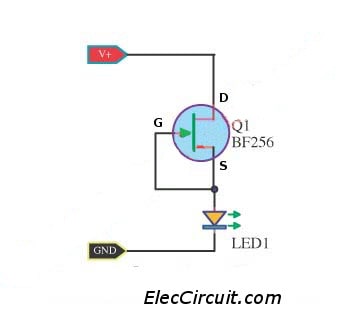
I use the number: BF256 normally it is used as an N-channel RF amplifier (in VHF/UHF frequency), it is a small size FET to-92 type. Use in voltage under 30-volts. And see a position lead (Gate, Source, and Drain lead) or BF256 Pinout in Figure.
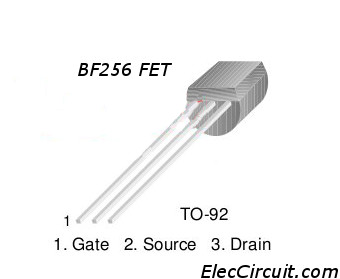
And I test it on a breadboard as the video below. I use the power supply is … Adjustable dc voltage regulator circuit using ic-7805. which have a voltage output of 5V to 22V as we need. (TTL and CMOS voltage)
Firstly I adjust the voltage at 5V (see on the meter above) At the same time, I measure current that flow through LED have 4.22mA only. (see on the meter right) But LED is normal brightness. Normally LED has a current required of 15mA.
Then, I adjust voltage up, while the current is stable about 5mA only and the LED also stable brightness as we need…happy circuits.
2# Constant current circuit using LED
This is a constant current circuit using LED. Normally, the voltage drop across LED while forward bias will be about 1.2 to 1.4 volts. It depends on the type of LED, which has a temperature coefficient is -1.5 mV per degree celsius. It is similar to the temperature coefficient of junction between a base and emitter of silicon transistors.
We can draw a block diagram to illustrate this, as in the figure below
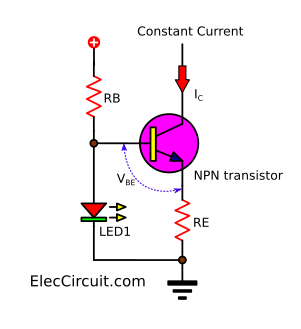
Constant current circuit using LED
From the Figure, We can calculate the IC current flowing through the collector of transistor as formula below
(VLED – VBE) / RE
Since the temperature coefficient of the transistor and LED is fully offset.
Thus, the occurring temperature does not affect the current flowing through the transistor(IC).
We love this circuit, we will apply it.
Read more: Constant current circuit using transistors
3# 7805 current constant circuit
We use also a 7805 regulator to build a constant current circuit. It is a simple charger circuit.
Recommended: 7805 datasheet and sample circuits
Or the current regulator using IC-7805.
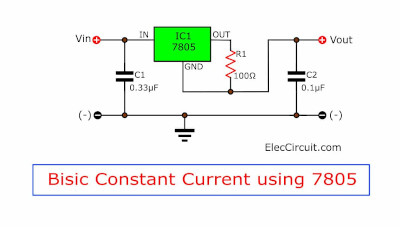
Basic current constant or current regulator using 7805
In the datasheet, if using a resistor-R1 pass current from a pin output of IC to load.
Then, it gets the current output to pin ground, too.
The circuit inside 7805 can keep the output current is solid status.
Even we change any input voltage. But do not forget it run well over 5V input.
Read more: about how to find R1 in any case.
4# Precision LED Regulator using LM337T
Here is alternatively use LED with power supply many the level Voltage.
Look at the circuit.
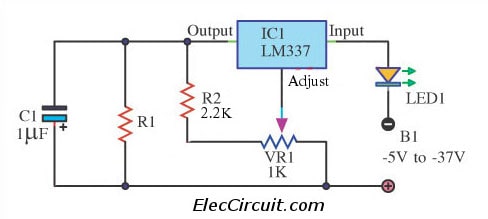
The LED1 will get a stable current. Some called Precision LED Regulator Circuit using LM337T.
The Pros of this circuit is using a few parts.
And you should use input voltage from -5V to -37V. Because this IC is a negative voltage regulator.
Change R2 to control the trend (Adjustable (+/-)15%).
For R1: if get from I LED1 = 1.5V / R1, R2 such as ILED1 = 15mA , R1 = 100 ohms.
5# Stabilised Current Battery Charger using LM723
Normally battery Charger Circuit, will use the way gives Stabised Current or stable current. For this circuit also the integrated circuit LM723 and electronic parts a few with follow the circuit appraise R1 = 11ohm for fix current at 60mA.
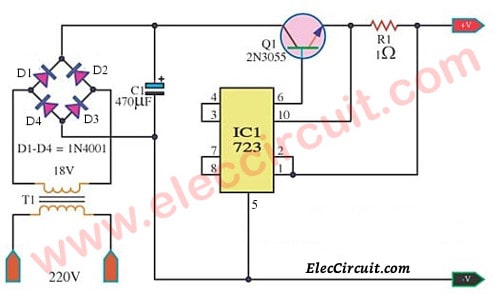
We can seek the value R get from R = 700/I and The transistor 2N3055 add keep for enlarge current the paramour at LM723 , durable get , make have the wastage of power to electricity work about 1.6Watt only. For voltage output be valuable about 7.5V then choose use battery voltage low get only. The detail is other, Friends see in the circuit has please yes.
6# The Safe constant current source
Look at the circuit below. It is a Safe constant-current source circuit, how it works?
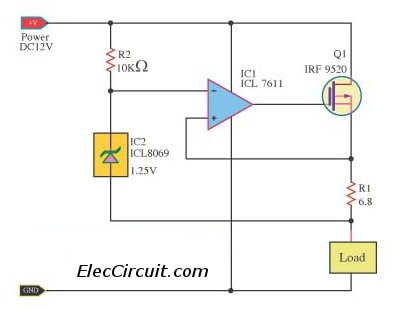
A CMOS op-amp (number ICL 7611) controls the input current through a P-channel Hexfet power transistor (No. IRF 9520), then to keep up a constant voltage across the R1.
As they are connected in a serial form, so use the together current by I = VREF / R1, while the Vref to be defined by the IC2 is 1.25V.
The advantage of this outline are:
1. The load current is limited by R1 when the load is too heavy.
2. The op-amp and Hexfet there is the overhead voltage very low.
7# Precision current sink circuit
This is a current sink circuit that uses a transistor, Jfet and LM101 IC op-amp, so there is high precision.
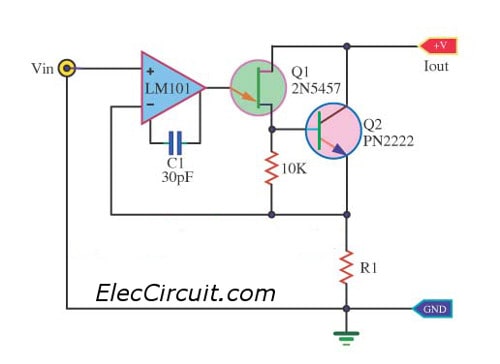
The 2N5457 Jfet and PN2222 bipolar have normally high output impedance.
The R1 is used as a current sensing resistor, to provide feedback to the LM101 op-amp that it supplies a large amount of loop gain for negative feedback, to enhance the real current sink nature.
The value of Iout is Vin/ R1, by Vin more than 0V.
For low current values, the 10K resistor and PN2222 may be clear out, if the source of the Jfet is connected to R1.
Related Posts

I love electronics. I have been learning about them through creating simple electronic circuits or small projects. And now I am also having my children do the same. Nevertheless, I hope you found the experiences we shared on this site useful and fulfilling.



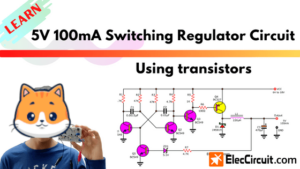
Hello Apichet.! I want to design a safe battery charger for my RC model airplanes. My RC Club will not allow us to use anything powerful which could cause a fire since we have methanol fuels in our hangar.
I imagine using four AA alkaline batteries in series giving 6V out as my source to charge my 4 cell NiMH battery in the airplane with nominal voltage 4.8V. One such charger per airplane – giving say 10-20mA charging current – would provide constant access to any of my airplanes being ready for flying at any time.
I looked at your design above: #2 Constant Current Circuit using LED” which would add the benefit of a LED showing that charging is ON..! Could you please elaborate a bit on that design so I understand exactly how to connect in my application. THANK YOU.!
Also I wonder if #2 is a good design which does NOT unnecessarily drain my sorce battery to just produce useless heat..??!!
Very Best Regards/Harald Brötell, Sweden
[email protected]
Hello Harald Brötell,
We are very glad that you were interested in this article. You are awesome. Your work is really interesting.
It’s very rewarding to build and learn electronic projects. I think so, and so are you.
We have now experimented with a constant current circuit and built a battery charging circuit.
The article is being prepared.
Thanks again